And so I organized the exhibit around some of the ways humans have pictured animals in the city over the past century and a half, identifying six main points of view. Hobokenites had variously considered animals as neighbors (living side-by-side, especially when the city still had its original meadowlands), as workers (mostly conveying people and goods), as sources of food and clothing, as pests and strays targeted for destruction, as sources of entertainment or spectacle, and as companions and family.
I’ve put selections from each category online, along with selected photos, photos, prints, maps, documents and art.
 hen I proposed an exhibit on “city animals” to the Hoboken Historical Museum, I knew I wanted to explore interaction between the city’s humans, and domesticated, companion, wild, and “exotic” animals, over the past 150 years. I wasn’t sure, at first, how I would organize the display and its attendant catalogue, but a direction became clear as I sifted through documents, and reviewed photographs, objects, and art. I realized the exhibition could not follow a strict chronology, as doing so might imply a history of steady evolution or enlightened behavior not borne out by facts. And unlike other exhibits I’d organized, which often focused on the lives of poor or marginalized residents previously absent from history texts, this display could not voice “the other side;” it could only present the perspective of the dominant group, accompanied, perhaps, by an awareness of the other’s silence. An exhibit on city animals would ultimately be about humans, a record of our wants—and also, my research told me, about how our wants had shifted and changed, and sometimes doubled back, over time.
hen I proposed an exhibit on “city animals” to the Hoboken Historical Museum, I knew I wanted to explore interaction between the city’s humans, and domesticated, companion, wild, and “exotic” animals, over the past 150 years. I wasn’t sure, at first, how I would organize the display and its attendant catalogue, but a direction became clear as I sifted through documents, and reviewed photographs, objects, and art. I realized the exhibition could not follow a strict chronology, as doing so might imply a history of steady evolution or enlightened behavior not borne out by facts. And unlike other exhibits I’d organized, which often focused on the lives of poor or marginalized residents previously absent from history texts, this display could not voice “the other side;” it could only present the perspective of the dominant group, accompanied, perhaps, by an awareness of the other’s silence. An exhibit on city animals would ultimately be about humans, a record of our wants—and also, my research told me, about how our wants had shifted and changed, and sometimes doubled back, over time.




Manhattan was growing ever more crowded and industrialized, and Hoboken would not remain undeveloped for long. By the close of the century, construction, market hunting, a craze for caging wild songbirds, and the demands of the millinery and fur trades would decimate much of East Coast’s habitat and wildlife.
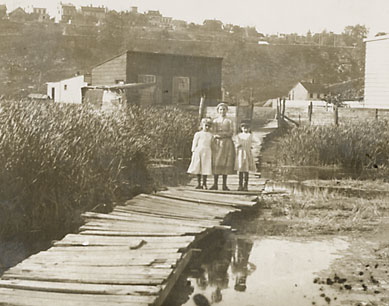
A few naturalists allowed others to study their specimens, thereby allowing the field of natural history to advance with fewer culls. Notable among them was William Cooper, son of a wealthy English merchant and later, a Hoboken resident. One of the founders of the Lyceum of Natural History (members later established the American Museum of Natural History) Cooper was originally known for his study of “the fossil bones of giant animals,” but he soon developed a reputation for his well-labeled “cabinets”—an assemblage of smaller, extant species, collected from the Northern and Middle States.


And yet, some city residents were outspoken in their support of domesticated animals—part of a broader vision of a better, more just society. Outstanding among them was Ottilie Assing, a Hoboken-based, radical German journalist who translated Frederick Douglass’s autobiography into German and was his intimate friend for 28 years. “For any kindness done to animals, I feel personally thankful,” Assing remarked to Douglass in an 1878 letter that included her usual commentary on current events and their shared commitment to women’s emancipation and civil rights for African Americans.
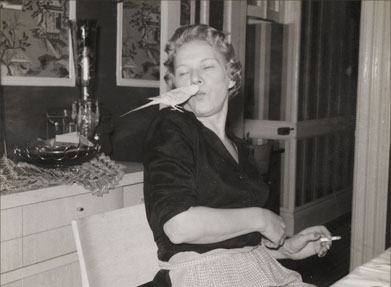
Assing was a strong supporter of the American Society for the Prevention of Cruelty to Animals, which had been founded in 1866. Her last will and testament established both a trust fund for Frederick Douglass “for the term of his natural life” and provided a large bequest to the ASPCA. The funds, released after her death in 1884, would help secure the organization’s future as the new century approached.
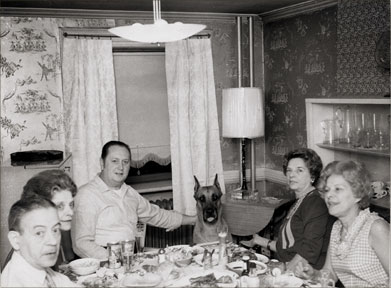
During the 1960s, Paul Kostka, a city policeman, lived in a Garden Street row house with his family, which included a very small bird and a very large dog. (A photograph of Paul’s wife, Mary, and her bird, opens this section of City Animals.) When their Great Dane, Leon, died in 1975, Paul created a memorial in the backyard. A Jersey Journal article later noted that “an ever-burning light” glowed about the urn that held Leo’s cremated remains.
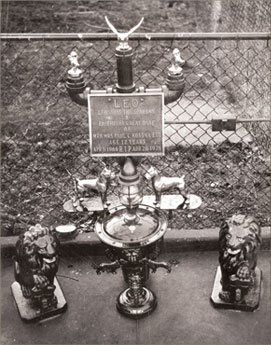
When Hoboken artist Jennifer Place’s collie, Frank, died in April 2001, she, like Paul Kostka, was a homeowner and had sufficient land around her house to bury her beloved dog. But she, too, needed to do more. Place had walked Frank through many Hoboken neighborhoods during their nine years together, and they had both acquired many friends. To them, she sent memorial cards she designed. And then, for Frank, and for herself, she set about creating a memorial art piece.
The idea for a “quivering stick,” she writes, came from Jim Crace’s 1999 novel Being Dead. The book describes a practice from a century ago that may have been an invention of the author:
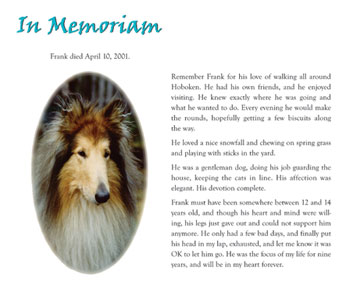
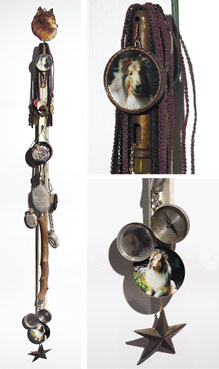
Some of these animals were originally adored, then reviled. The most extreme example of the pet-to-pests transformation may be the European or “English” sparrow. In the late 19th-century, only two decades after homesick immigrants had released a few of these prolific, city loving birds in Brooklyn, the U.S. Department of Agriculture launched the Great Sparrow War to exterminate them. At first, “they were petted and watched over,” a 1903 ornithology text notes. Special food and quarters were prepared for them for the winter and nesting boxes were installed in areas cleared of predators.
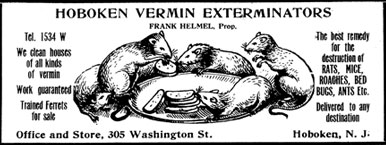
By 1889, the Department of Agriculture was in high gear, recommending firearms, traps, and feed laced with strychnine and arsenic to exterminate the English sparrow. State bounties paid for dead sparrows and millions were shot. But these methods did not rid U.S. cities of the English sparrow: the introduction of new building materials and the combustion engine did that. Without the nesting areas provided by old wooden buildings, and the grain-rich stables of horses, the population of English sparrows declined.

“Mad dog” scares were pushed out of the headlines during the summer of 1916 when a new fear struck East Coast cities: an epidemic form of polio or “infantile paralysis” that was most prevalent among middle-class children.

Library of Congress collection.
Eventually, experts came forward to refute any connection between polio and stray animals, but they persisted with their belief that poor people—“the great unwashed”—were the likely carriers. Historian Naomi Rogers would later note in her 1992 book Dirt and Disease, Polio Before FDR, that “the irony of the polio story is that health experts targeted just those homes”—the homes of poor, immigrant families—“in which children were likely to already be immune,” as they had been infected, and developed immunity, in infancy.
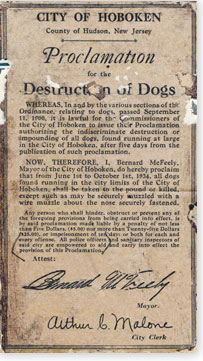
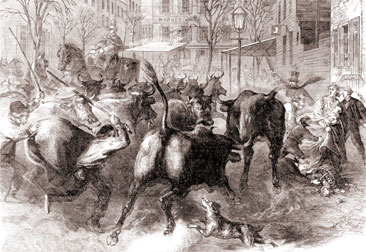
April 28, 1866.
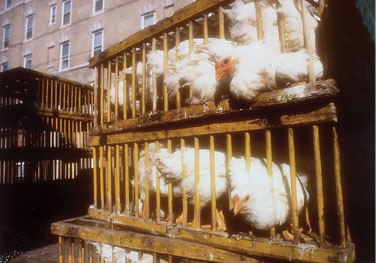
As a transportation hub with multiple rail lines, regular ferry service, and docking space for two trans-Atlantic steamship companies, Hoboken also hosted circuses and menageries when the traveling companies inaugurated trans-continental tours or prepared for performances in New York. Some, such as Lent’s equestrian company, offered a one-day exhibit in the city before leaving on their “grand excursion by railway.”
Circuses also treated Hoboken residents to amazing late-night displays: animal handlers would unload their exotic charges from rail cars or ships, then exercise them on the city’s main street.
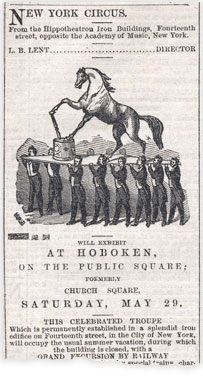
Five elephants, after performing stunts during a weeklong engagement on 14th Street in New York City, were transported to Hoboken by ferry. It was just before midnight. Third-generation Robinson Circus owner John G. Robinson was working with trainers to bring the elephants to railcars waiting to transport them to their next venue.

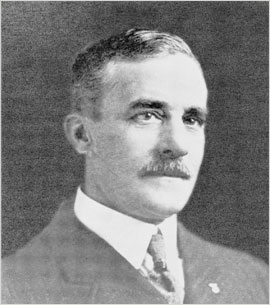
A Documentary on the Old John Robinson Circus.
Lizzie’s body was to be transported to Fire Island for burial, but I could find no record of the internment. John Robinson remained deeply devoted to the remaining elephants in his care. Even after bankruptcy forced him in 1916 to sell most of his equipment and animals to other circuses, he kept four elephants on the Terrace Park, Ohio, property—including his longtime favorite, Tillie, shown right. The Ohio property had always served as their winter quarters.

Courtesy of the Terrace Park Historical Society.
Despite the presence of riding trails and academies in the city, from the mid-19th century until the early part of the 20th-, most horses in Hoboken were “beasts of burden.” A 1909 plat book mapping city land shows the ubiquity of the worker-horse, with an urban grid regularly punctuated by stables, and block-long structures built for companies involved in cartage.

The perception of the horse as a prized and essential worker would not last much longer. The “horseless carriage” had arrived. By World War II, many Hoboken residents would view the horse as a source of cheap meat.
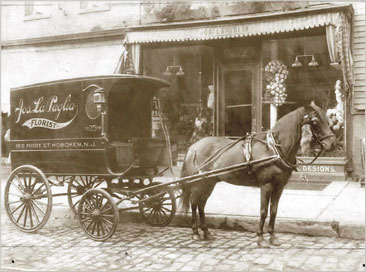

Top right: Stationery, Charles Hoffman & Co. Funeral Directors, 109-115 Jackson Street, 1911. Hoboken Historical Museum collection.
Bottom right: Postcard of horses and coal wagons lined up at Jagels & Bellis Coal Yards, 14th Street, ca. 1907. Private collection.

